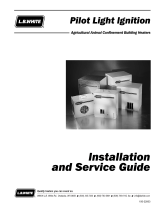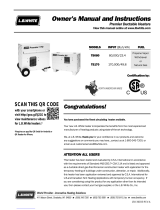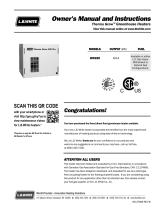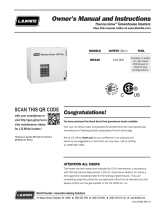
2
Regulations and guidelines
Logamax plus GB162- L.B. 80/100 kW - Subject to modifications resulting from technical improvements!
8
2 Regulations and guidelines
• The installation must conform to the requirements of
the authority having jurisdiction or, in the absence of
such requirements, to the National Fuel Gas Code,
ANSI Z223.1/NFPA 54 and/or CAN/CSA B149.1,
Natural Gas and Propane Installation Code.
• Where required by the authority having jurisdiction, the
installation must conform to the Standard for Controls
and Safety Devices for Automatically Fired Boilers,
ANSI/ASME CSD-1.
Install CO detectors per local regulations. Boiler requires
yearly maintenance, Æ chapter 12 "Maintenance",
page 53.
Operating Limits of the boiler:
Max. boiler temperature: 230 °F (110 °C)
Max. operating pressure: 30 psi (2.6 bar)
- with optional pressure relief valve 50 psi (3.45 bar)
The hot water distribution system must comply with
applicable codes and regulations. When replacing an
existing boiler, it is important to check the condition of the
entire hot water distribution system to ensure safe
operation.
2.1 Massachusetts Installations Only:
(a)
For all side wall side horizontally vented gas fuelled
equipment installed in every dwelling, building or structure
used in whole or in part for residential purposes, including
those owned or operated by the Commonwealth and where
the side wall exhaust vent termination is less than 7 feet
above finished grade in the area of the venting, including but
not limited to decks and porches, the following requirements
shall be satisfied:
1. INSTALLATION OF CARBON MONOXIDE DETECTORS.
At the time of installation of the side wall horizontal vented
gas fueled equipment, the installing plumber or gas fitter shall
observe that a hard wired carbon monoxide detector with an
alarm and battery back-up is installed on the floor level where
the gas equipment is to be installed. In addition, the installing
plumber or gas fitter shall observe that a battery operated or
hard wired carbon monoxide detector with an alarm is
installed on each additional level of the dwelling, building or
structure served by the side wall horizontal vented gas fueled
equipment. It shall be the responsibility of the property owner
to secure the services of qualified licensed professionals for
the installation of hard wired carbon monoxide detectors
– In the event that the side wall horizontally vented gas
fueled equipment is installed in a crawl space or an attic,
the hard wired carbon monoxide detector with alarm and
battery back-up may be installed on the next adjacent floor
level.
– In the event that the requirements of this subdivision can
not be met at the time of completion of installation, the
owner shall have a period of thirty (30) days to comply with
the above requirements; provided, however, that during
said 30 day period, a battery operated carbon monoxide
detector with an alarm shall be installed. alarm and battery
back-up may be installed on the next adjacent floor level.
2. APPROVED CARBON MONOXIDE DETECTORS. Each
carbon monoxide detector as required in accordance with the
above provisions shall comply with NPA 720 and be
ANSI/UL 2034 listed and IAS certified.
3.
SIGNAGE. A metal or plastic identification plate shall be
permanently mounted to the exterior of the building at a minimum
height of 8 ft. above grade directly in line with the exhaust vent
terminal for the horizontally vented gas fuelled heating appliance
or equipment. The sign shall read, in print size no less than 1-½"
in size, GAS VENT DIRECTLY BELOW. “KEEP CLEAR OF ALL
OBSTRUCTIONS”
.
4.
INSPECTION. The state or local gas inspector of the side wall
horizontally vented gas fuelled equipment shall not approve the
installation unless, upon inspections, the inspector observes
carbon monoxide detectors and signage installed in accordance
with the provisions of 248 CRM 5.08(2)(a)1 through 4.
(b)
EXEMPTIONS: The following equipment is exempt from
248 CRM 5.08(2)(a)1 through 4:
The following equipment is exempt from 248 CRM
5.08(2)(a)1 through 4:
1. The equipment listed in Chapter 10 entitled “Equipment Not
Required To Be Vented” in the most correct edition of NFPA
54 as adopted by the board: and
2. Product Approved side wall horizontally vented gas fueled
equipment installed in a room or structure separate from the
dwelling, building or structure used in whole or in part for
residential purposes.
(c)
MANUFACTURERS REQUIREMENTS - GAS
EQUIPMENT VENTING SYSTEM REQUIRED.
When the manufacturer of Product Approved side wall
horizontally mounted gas equipment provides a venting
system design or venting system components with the
equipment, the instructions provided by the manufacturer for
the installation of the equipment and venting shall include:
1. Detailed instructions for the installation of the venting system
or the venting system components: and
2.
A complete parts list for the venting system design or venting
system.
(d)
MANUFACTURERS REQUIREMENTS - GAS
EQUIPMENT VENTING SYSTEM NOT PROVIDED.
When the manufacturer of Product Approved side wall
horizontally vented gas fueled equipment does not provide
the parts for the venting of flue gases, but identifies “special
venting systems”, the following requirements shall be
satisfied by the manufacturer:
1. The referenced “special venting systems” shall be included
with the appliance or equipment installation instructions: and
2.
The “special venting systems” shall be Product Approved by the
Board, and the instructions for that system shall include a parts
list and detailed installation instructions.
(e)
A copy of all instructions.
For all Product Approved side wall horizontally vented gas
fueled equipment, all venting instructions, all parts lists for
venting instructions, and/or venting design instructions shall
remain with the appliance or equipment at the completion of
the installation.























